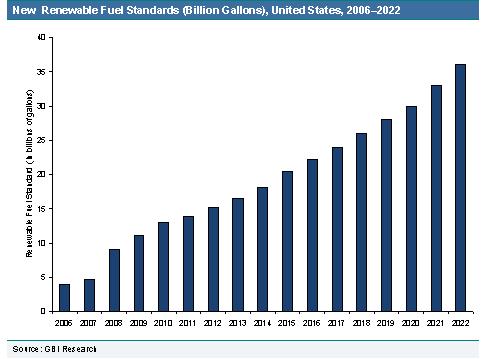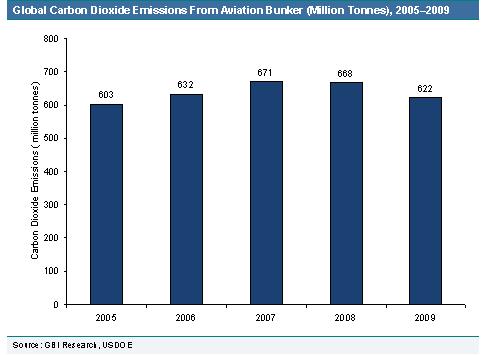Green Aviation Market to 2020 - Stringent Regulations to Drive Investment in Green Technologies
28 Oct 2010 • by Natalie Aster

London - The global aviation industry annually contributes around 2-3 % of total worldwide anthropogenic carbon dioxide emissions. Though, the emissions from the aviation industry currently account for a small part of total man-made emissions, the escalating demand for the aviation industry will be a major reason for increased emissions. Furthermore, the growth in air traffic over the last couple of decades has outweighed the contribution of significant improvements in aircraft technology and aircraft operations.
GBI Research believes that in the years ahead, the aviation industry will turn to green technologies in order to develop business-led solution to address climate change. Tightening regulations on the aviation industry to curb its emissions will drive green aviation technology market in general and the aviation biofuels and fuel cells market in particular. GBI Research anticipates the green aviation market will reach $412.1 billion in 2020 from $80m in 2009.
Rising Emissions from Aviation Industry and Stringent Environmental Regulations Accentuate the Need for Green Technologies in Aviation Market
GBI Research believes that air transport demand will follow economic recovery, thus, the global economic recovery is expected to create a robust growth in the demand for air travel. There is a marked correlation between economic growth and air travel as economic growth influences the demand for air transportation. Industry experts are of the view that for every 1% increase in global economic growth, there is a 2.5–3% increase in global air traffic. However, there is growing concern regarding the effects of aircraft emissions on the environment.
Fortunately, there is common vision among industry stakeholders in reducing the impact of aviation on climate change — measures for development and implementation of new and sustainable energy source for aviation worldwide and producing innovative aircraft design and materials are most likely outcome.
The graph below shows the total carbon dioxide emissions from the aviation bunker for the period 2005–2009.
Due to the rising level of emissions from the aviation industry, several initiatives are being implemented at global and local levels. One such initiative taken by the US Environmental Protection Agency (EPA) mandates a minimum volume of renewable-source fuel in transportation fuels. The EPA is responsible for the development and implementation of regulations which are related to transportation fuel sold in the US. The new regulations ensure that transportation fuel contains a minimum volume of renewable fuel. This standard was developed in collaboration with many key stakeholders in the fuel industry, which includes refiners and renewable fuel producers. The Renewable Fuel Standard (RFS) program regulations, as they’re known, were created under the Energy Policy Act (EP Act) of 2005. The RFS program was first to create a renewable fuel mandate in United States. Under the original RFS program, the EPA required 7.5 billion gallons of renewable fuel to be blended into gasoline by 2012. The figure below shows the new renewable fuel standard indicating the growing importance of renewable fuels in the US.
Reductions in Fuel Cell Costs Will Spur Their Deployment in the Green Aviation Market
Reductions in the cost of fuel cell which are used to provide auxiliary power in aircrafts are expected to spur their deployment in the green aviation market. The costs of fuel cells have been decreasing in the last few years and GBI Research anticipates that the trend will continue in the future. The reducing cost of fuel cells will open up the market for fuel cells in the aviation fuel sector, as well as others. GBI Research understands that the reducing costs will be a key driver for the fuel cell market. According to industry analysts, fuel cell costs have reduced drastically because initiatives were taken by the fuel cell industry to reduce the platinum loading of fuel cells, which when present in large amounts increased the cost of fuel cells considerably. The green aviation fuel cell market is expected to grow at a Compound Annual Growth Rate (CAGR) of 184.8% for the period 2010–2020, and reach $ 140.2 billion by the end of 2020.
Lack of Standards Associated with Aviation Environmental Sustainability
The green aviation industry lacks rigorous standards which could move the market towards achieving sustainability. There is no common standard which can act as a benchmark for the aviation industry’s efforts to reduce their adverse effect on the environment. GBI Research anticipates that this may be a concern for the aviation industry as a whole. Standardizing the aviation processes which are responsible for key emissions would open up various markets and also act as a catalyst to speed up the process for achieving environmental sustainability. GBI research believes that one such type of market is the global aviation advanced composite market, which would open up with the standardization of advanced composites for their applications in the aviation industry. The green aviation advanced composite market is in an introductory stage and need to be galvanised by efforts towards standardization. The green aviation advanced composite market is expected to reach $200m by the end of 2020, with a CAGR of 9.6% for the period 2010–2020.
Urge for Energy Independence Will be a Key Driver for the Green Aviation Biofuels Market
The global drive to reduce dependence on expensive crude oil will be key driver in the growth of the biofuels market. Global economies are currently aiming for a shift towards clean, domestically produced alternative fuels and renewable energy sources and away from expensive foreign oil. The global aviation market will benefit from this trend in the global economy. The initiatives for global energy independence will lead to the development of new transport fuels which will drive the global biofuels market. In the short term, the impact of energy dependence on the global biofuels market will be moderate as most of the associated economic developments are still in the initiation stage. The impact of energy independence will be a key driver in the long term, when the global economies will be committed to the production of alternate fuels on their own. The global biofuels market behavior for the period 2009–2020 is shown in the figure below.
The green aviation biofuels market is currently in an embryonic stage, and achieving sustainability will be a key driver for the green aviation biofuels market. The green aviation biofuels market is expected to reach $271.7 billion by the end of 2020, with a CAGR of 177.6% for the period 2010–2020.
The Green Aviation Market to 2015 – Stringent Regulations to Drive Investment in Green Technologies by GBI Research provides key information and analysis on the market opportunities in the Green Aviation Market. The report gives the latest information on the global green aviation revenues with a detailed assessment of the market forces influencing the global green aviation market.
Report Details:
The Green Aviation Market to 2015 – Stringent Regulations to Drive Investment in Green Technologies
Published: Oct, 2010
Pages: 111
Price: US$ 3,500.00
The study provides market information on the green aviation market industry on the basis of geography. Global aviation industry has an annual contribution of 2% to 3% of the total anthropogenic carbon dioxide emissions. The emissions from aviation industry now accounts for a small part of the total emissions but the escalating demand for aviation will be a major reason for increased emissions from the aviation industry. Growing concerns over climate change and anticipated rise in carbon prices and increased cost of compliance are major drivers for the green aviation industry.
The report “The Green Aviation Market to 2015 – Stringent Regulations to Drive Investment in Green Technologies” talks about analysis of key stakeholder initiatives, energy industry trends, macroeconomic factors, and give a bird's eye view of global commercial aviation alternative fuel market with strategic conclusions and recommendations. It has a dedicated chapter on the regulatory framework that includes government policies, standards, and key measures and so on, and provides comprehensive profiles of key players in the industry. This report is built using data and information sourced from proprietary databases, primary and secondary research and in-house analysis by GBI Research's team of industry experts.
To order the report or ask for sample pages contact [email protected]
Contacts
MarketPublishers, Ltd.
Mrs. Alla Martin
Tel: +44 208 123 2220
Fax: +44 207 900 3970
[email protected]
www.marketpublishers.com
Analytics & News



